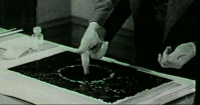








Katherine Blodgett (1898-1979) was a woman of many firsts. She was the first female scientist hired by General Electric’s Research Laboratory in Schenectady, New York (1917) as well as the first woman to earn a Ph.D. in Physics from Cambridge University (1926). She was the first woman to receive the Photographic Society of America Award and the American Chemical Society honored her with the Francis P. Garvin Medal.
Katherine Blodgett’s research on monomolecular coatings with Nobel Prize winning Dr. Irving Langmuir led her to a revolutionary discovery. She discovered a way to apply the coatings layer by layer to glass and metal. The thin films, which naturally reduced glare on reflective surfaces, when layered to a certain thickness, would completely cancel out the reflection from the surface underneath. This resulted in the world’s first 100% transparent or invisible glass. Katherine Blodgett’s patented film and process (1938) has been used for many purposes including limiting distortion in eyeglasses, microscopes, telescopes, camera and projector lenses.
Katherine Blodgett received U.S patent #2,220,660 on March 16, 1938 for the "Film Structure and Method of Preparation" or invisible, nonreflective glass. Katherine Blodgett also inventec a special color gauge for measuring the thickness of these films of glass, since 35,000 layers of film only added up to the thickness of a sheet of paper.